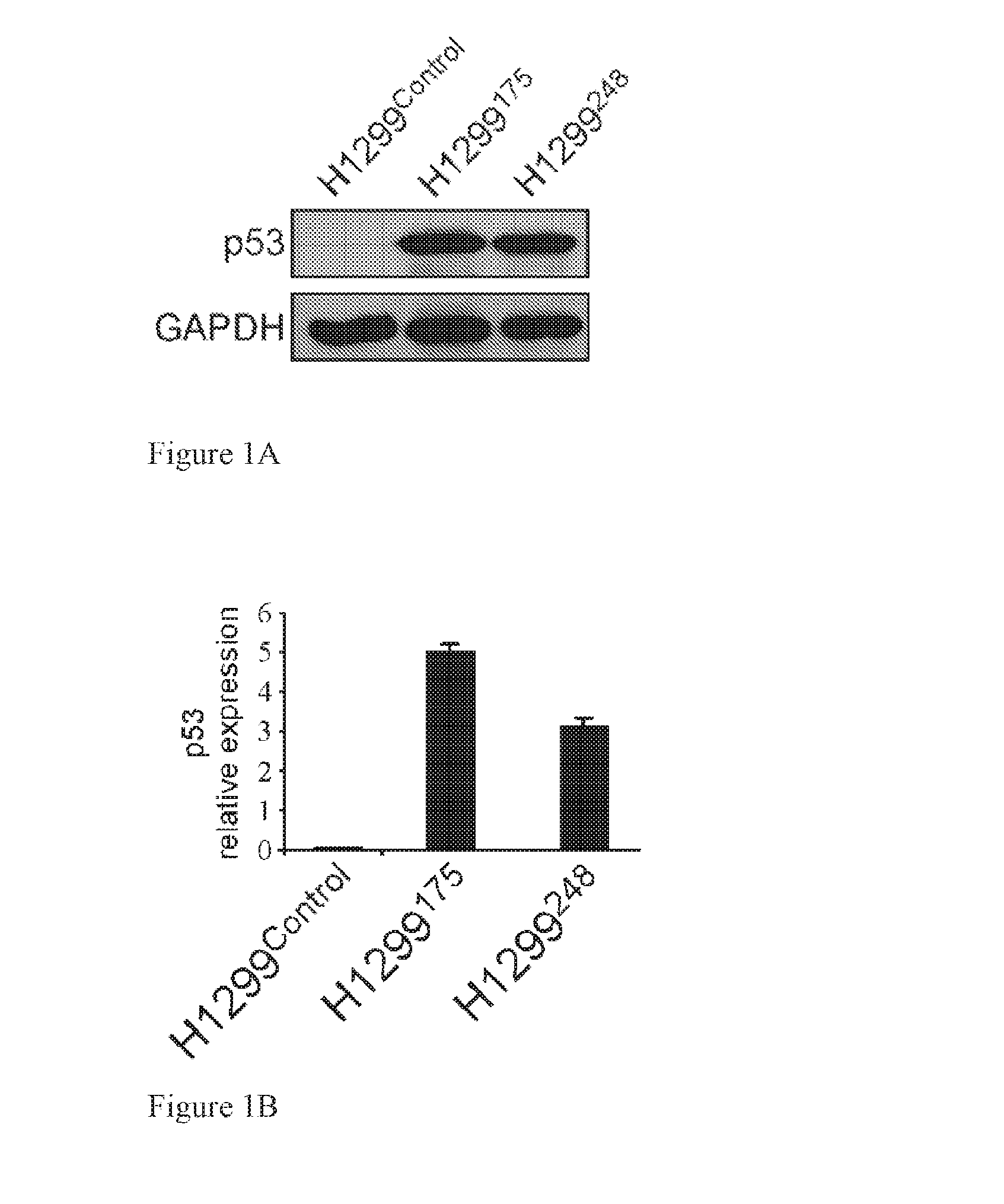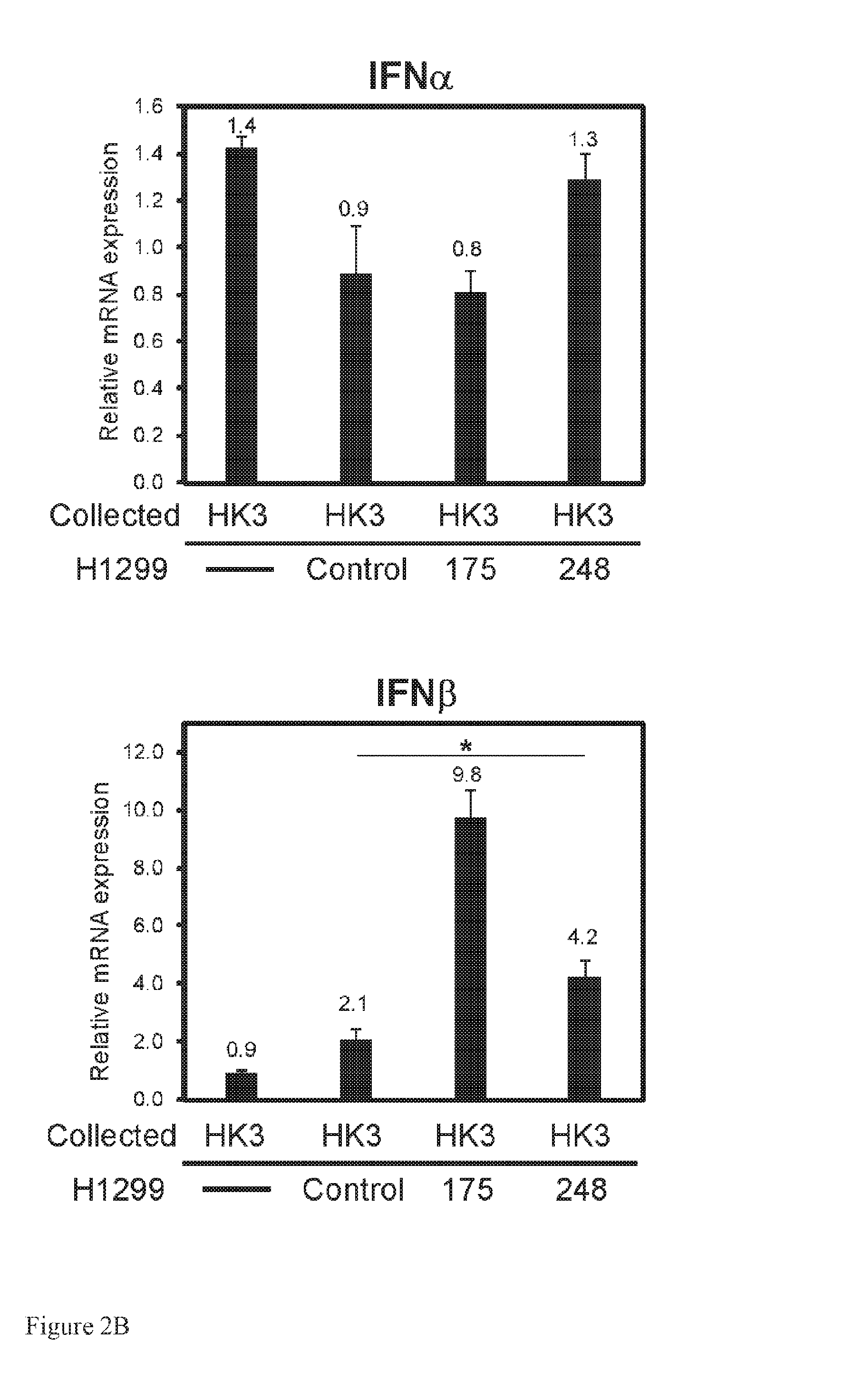Interferon treatment targeting mutant p53 expressing cells
- Summary
- Abstract
- Description
- Claims
- Application Information
AI Technical Summary
Benefits of technology
Problems solved by technology
Method used
Image
Examples
example 1
Establishment of an In Vitro Model to Study the Tumor-Stroma Encounter in Lung Cancer
[0303]As stromal cells often reside in, or are recruited to the vicinity of the tumor, an in vitro co-cultivation model was established that recapitulates this encounter and permits an efficient separation and characterization of the two cell populations. Lung cancer cells (H1299) which are null for p53 expression were introduced with two p53 totspof mutations residing within the DNA binding domain, namely R175H and R248Q (H1299175 and H1299248 respectively, FIGS. 1A and B). The cells were then labeled with a red fluorescent protein (dsRed), while lung CAFs (HK3-T) were labeled with a green fluorescent protein (GFP). The labeled populations were co-cultivated for 24 hours and separated by Fluorescence Associated Cell Sorting (FACS) based on their specific fluorescent marker. To minimize the possibility of cross contamination, the separated populations were sorted again, and indeed, the level of cros...
example 2
CAFs Invoke the Interferon Beta Pathway in Response to the Presence of Cancer Cells
[0306]To gain insights into the gene expression profile of stromal cells following the encounter with mutant p53 expressing cancer cells, the differentially expressed genes (two fold change or more, 0.05 p-value or less) in HK3-T before and after co-cultivation with either p53 null, H1299175 or H1299248 cancer cells via micro-array were analyzed. This comparison yielded a list of 875 differentially expressed genes that were clustered into 8 distinct groups by the CLICK algorithm using the Expander package (version 5.2). Of note, is the first cluster (‘HK3-T cluster’) composed of a group of 414 genes induced by the mere co-cultivation with carcinoma cells. This induction was further enhanced in the presence of mutant p53 expressing cells. The ‘HK3-T cluster’ was further characterized by the use of IPA algorithm (Ingenuity® Systems) which identifies enriched Gene Ontology annotations and canonical pathw...
example 3
Mutant p53-Bearing Cells Moderate CAFs-Mediated Interferon Response
[0309]In order to investigate the effect of mutant p53 in cancer cells on the surrounding fibroblasts, the micro-array data obtained from the sorted H1299 were analyzed. Over-viewing differentially expressed IFN targets in H1299 that were grown alone or cultivated with CAFs, 3 major expression patterns were revealed: (i) responsiveness, namely both p53 null and mutant p53 bearing cells induced known IFN targets in a comparable manner, (ii) over-induction, in which IFN targets were highly induced by mutant p53 cells and (iii) attenuation, where IFN targets-induction was mitigated by mutant p53. Genes were identified by using one or more genes from each pattern as a bait vector and searched for other genes that exhibited a Pearson correlation of at least 0.9 to the bait vector, using a custom Matlab script (FIG. 3A). Next, the frequency of IFN targets was evaluated in each pattern, using the Intefreome database (See IF...
PUM
| Property | Measurement | Unit |
|---|---|---|
| Cell death | aaaaa | aaaaa |
| Electrical resistance | aaaaa | aaaaa |
| Toxicity | aaaaa | aaaaa |
Abstract
Description
Claims
Application Information
 Login to View More
Login to View More - R&D
- Intellectual Property
- Life Sciences
- Materials
- Tech Scout
- Unparalleled Data Quality
- Higher Quality Content
- 60% Fewer Hallucinations
Browse by: Latest US Patents, China's latest patents, Technical Efficacy Thesaurus, Application Domain, Technology Topic, Popular Technical Reports.
© 2025 PatSnap. All rights reserved.Legal|Privacy policy|Modern Slavery Act Transparency Statement|Sitemap|About US| Contact US: help@patsnap.com



